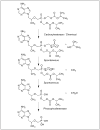Prodrug and conjugate drug delivery strategies for improving HIV/AIDS therapy
- PMID: 20717488
- PMCID: PMC2921722
- DOI: 10.1016/s1773-2247(09)50001-9
Prodrug and conjugate drug delivery strategies for improving HIV/AIDS therapy
Abstract
Despite the wide variety of highly potent anti-HIV drugs that have been developed and made available in clinical practice over the years, eradication of HIV infection has not been achieved. Currently, HIV infection and AIDS are thought to be chronically treatable. HIV attacks host immune cells namely macrophages and CD4(+)T-cells and sequesters itself into sanctuary and reservoir sites such as the lymphoid tissues, testes, and brain. Initial drug delivery efforts with prodrugs and drug conjugates focused on improving the physicochemical (i.e. solubility), biopharmaceutic (i.e. absorption, metabolism), and pharmacokinetic (i.e. blood concentrations) properties of the parent drugs. Eradicating HIV, however, will require advanced drug delivery approaches in order to access and maintain effective drug concentrations for prolonged periods of time in sanctuary sites. The current review discusses prodrug/conjugate efforts, clinical successes and describes drug delivery challenges and approaches for eradicating HIV infection.
Figures











Similar articles
-
Long-acting slow effective release antiretroviral therapy.Expert Opin Drug Deliv. 2017 Nov;14(11):1281-1291. doi: 10.1080/17425247.2017.1288212. Epub 2017 Feb 6. Expert Opin Drug Deliv. 2017. PMID: 28128004 Free PMC article. Review.
-
Tuberculosis.In: Holmes KK, Bertozzi S, Bloom BR, Jha P, editors. Major Infectious Diseases. 3rd edition. Washington (DC): The International Bank for Reconstruction and Development / The World Bank; 2017 Nov 3. Chapter 11. In: Holmes KK, Bertozzi S, Bloom BR, Jha P, editors. Major Infectious Diseases. 3rd edition. Washington (DC): The International Bank for Reconstruction and Development / The World Bank; 2017 Nov 3. Chapter 11. PMID: 30212088 Free Books & Documents. Review.
-
Drug delivery strategies and systems for HIV/AIDS pre-exposure prophylaxis and treatment.J Control Release. 2015 Dec 10;219:669-680. doi: 10.1016/j.jconrel.2015.08.042. Epub 2015 Aug 24. J Control Release. 2015. PMID: 26315816 Free PMC article. Review.
-
Design strategies in the prodrugs of HIV-1 protease inhibitors to improve the pharmaceutical properties.Eur J Med Chem. 2017 Oct 20;139:865-883. doi: 10.1016/j.ejmech.2017.07.044. Epub 2017 Jul 22. Eur J Med Chem. 2017. PMID: 28865281 Review.
-
Synthesis of poly(ethylene glycol)-based saquinavir prodrug conjugates and assessment of release and anti-HIV-1 bioactivity using a novel protease inhibition assay.Bioconjug Chem. 2004 Nov-Dec;15(6):1322-33. doi: 10.1021/bc0498875. Bioconjug Chem. 2004. PMID: 15546199
Cited by
-
Prodrug Therapies for Infectious and Neurodegenerative Diseases.Pharmaceutics. 2022 Feb 26;14(3):518. doi: 10.3390/pharmaceutics14030518. Pharmaceutics. 2022. PMID: 35335894 Free PMC article. Review.
-
Harnessing nanostructured systems for improved treatment and prevention of HIV disease.Bioeng Transl Med. 2018 Jul 27;3(2):102-123. doi: 10.1002/btm2.10096. eCollection 2018 May. Bioeng Transl Med. 2018. PMID: 30065966 Free PMC article. Review.
-
Unexpected Stability of a Prodrug to Enzymatic Hydrolysis within a Hydrated HPMC Matrix Tablet.Pharmaceutics. 2022 Oct 18;14(10):2222. doi: 10.3390/pharmaceutics14102222. Pharmaceutics. 2022. PMID: 36297657 Free PMC article.
-
Getting into the brain: Potential of nanotechnology in the management of NeuroAIDS.Adv Drug Deliv Rev. 2016 Aug 1;103:202-217. doi: 10.1016/j.addr.2016.02.008. Epub 2016 Mar 2. Adv Drug Deliv Rev. 2016. PMID: 26944096 Free PMC article. Review.
-
Long-acting slow effective release antiretroviral therapy.Expert Opin Drug Deliv. 2017 Nov;14(11):1281-1291. doi: 10.1080/17425247.2017.1288212. Epub 2017 Feb 6. Expert Opin Drug Deliv. 2017. PMID: 28128004 Free PMC article. Review.
References
-
- Joint United Nations Programme on HIV/AIDS and The World Health Organization-2007. AIDS epidemic update. 2007. [Accessed[June 11, 2008]]. http://www.unaids.org/en/KnowledgeCentre/Resources/Publications/-2007_ep....
-
- Joint United Nations Programme on HIV/AIDS and The World Health Organization. 2006 report on the global AIDS epidemic. 2006. [[June 11, 2008]]. http://www.unaids.org/en/KnowledgeCentre/Resources/Publications/
-
- Merson M. The HIV-AIDS pandemic at 25 - the global response. N Engl J Med. 2006;354:2414–2417. - PubMed
-
- Piot P, Bartos M, Ghys P, Walker N, Schwartlander B. The global impact of HIV/AIDS. Nature. 2001;410:968–973. - PubMed
-
- Flexner C. HIV drug development: the next 25 years. Nat Rev Drug Discov. 2007;6:959–965. - PubMed
Grants and funding
LinkOut - more resources
Full Text Sources
Other Literature Sources
Research Materials
